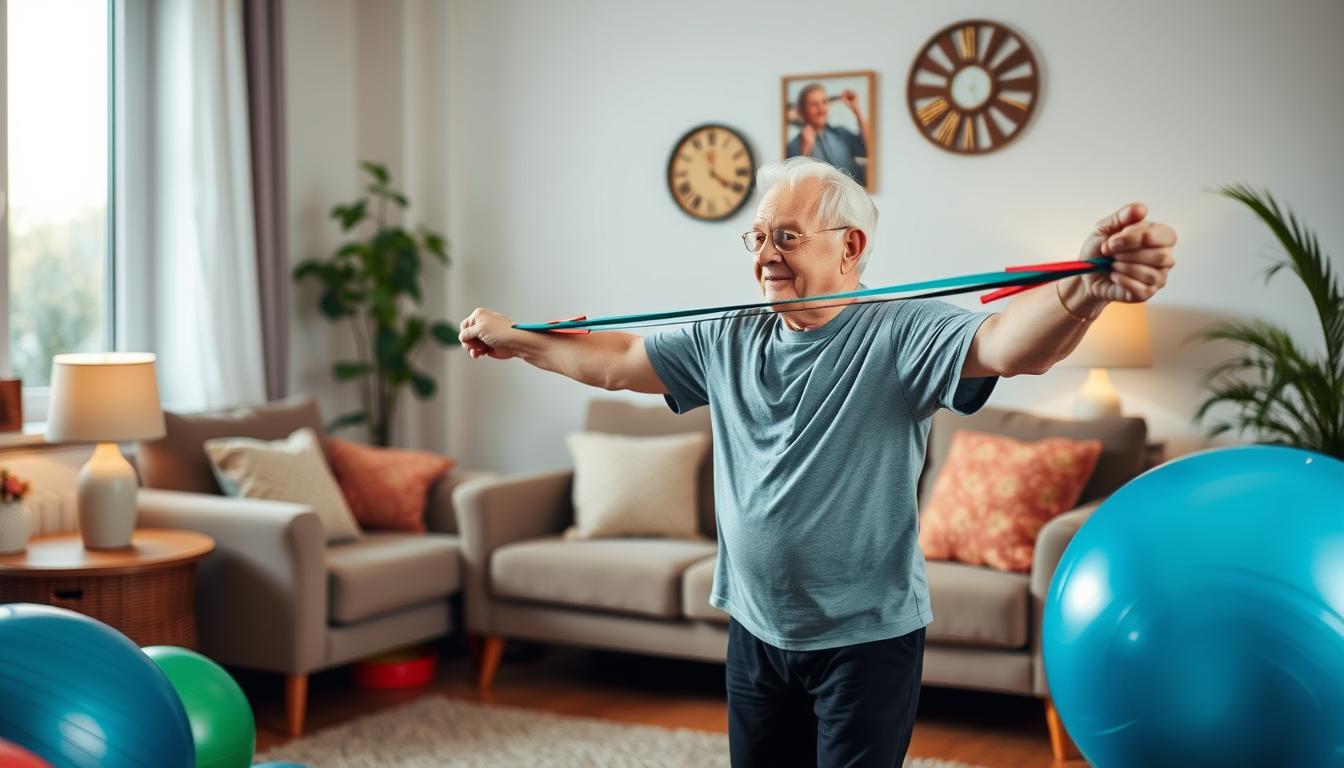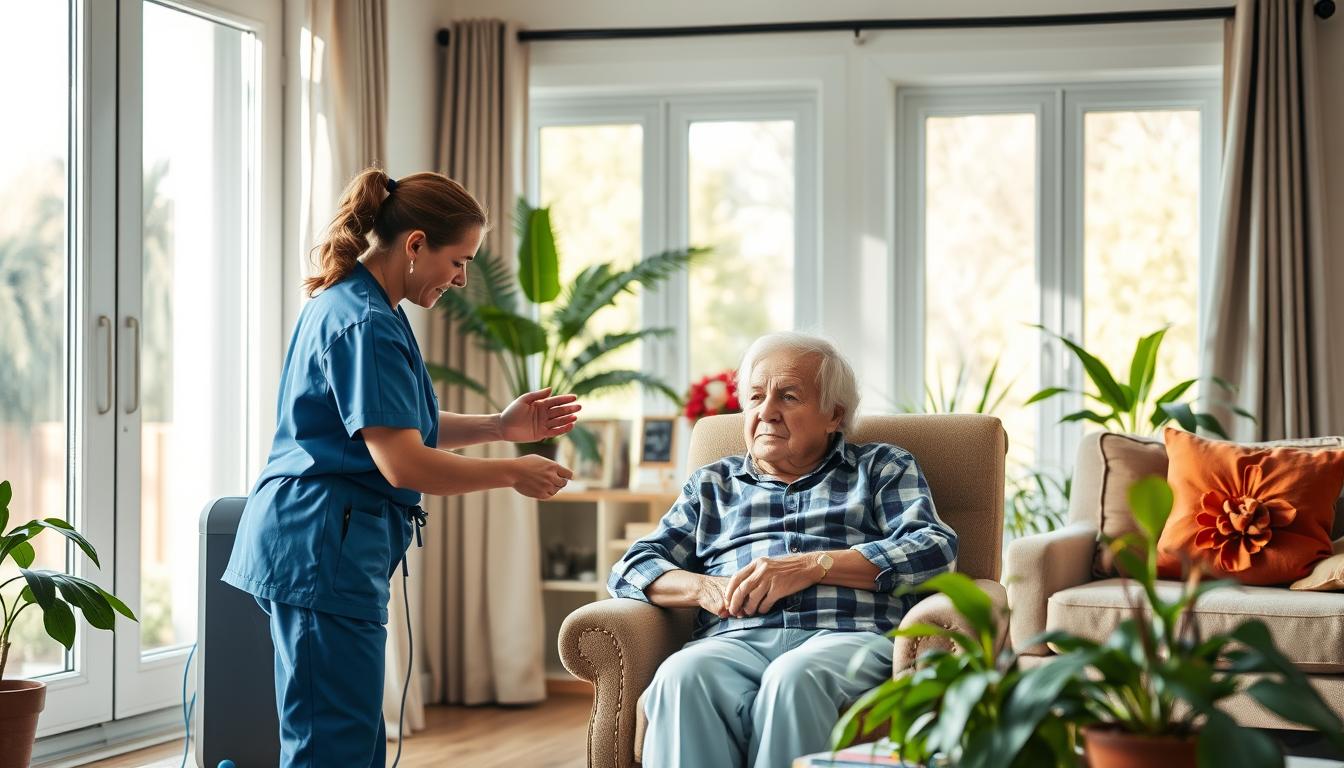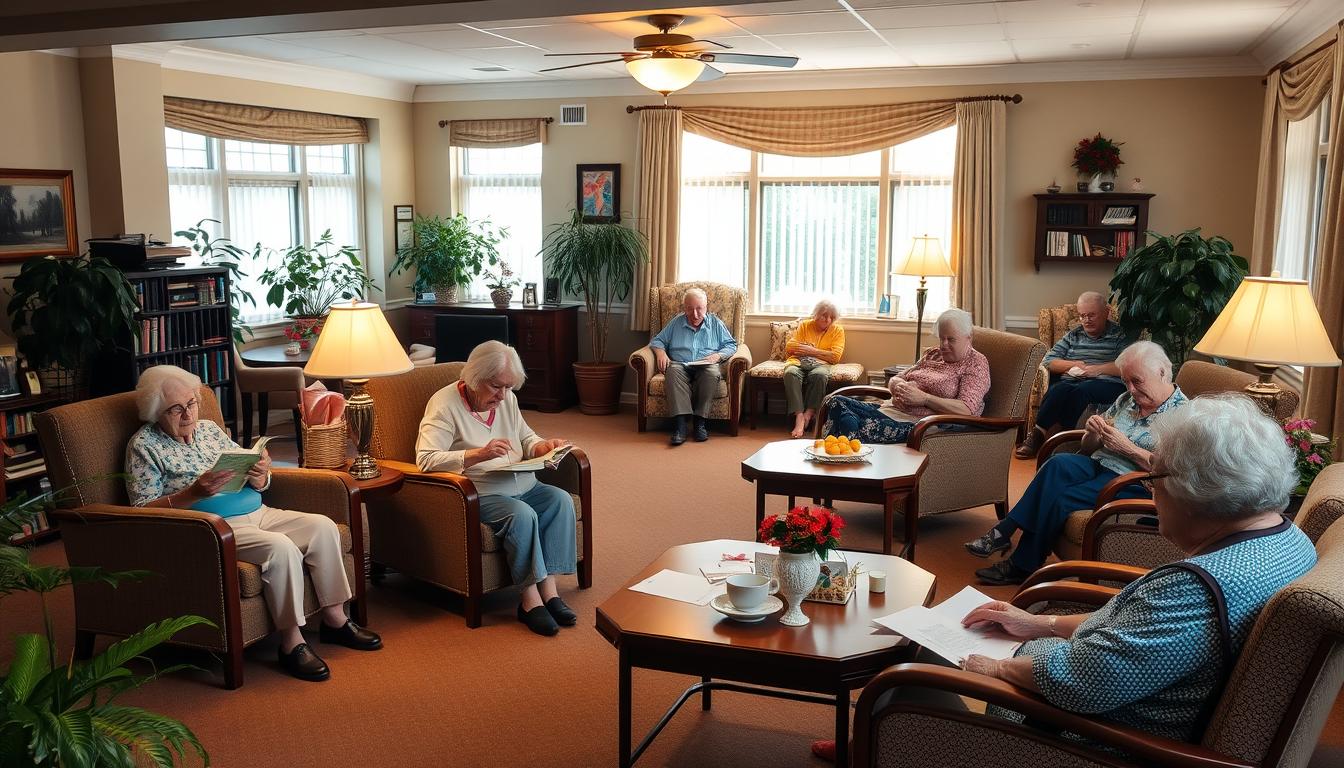As we age, our bodies need more care to stay strong and move easily. Physical therapy at home is a special way to keep seniors active and independent.
Home physical therapy helps seniors build strength, endurance, and balance. It also prevents muscle loss, lowers fall risks, and boosts daily activities.
In-home therapy offers a cozy, personalized space for recovery. It’s great for those with long-term health issues or after surgery.
Medicare often pays for these services, making them available to many older adults. Home therapy has fewer infection risks and involves family, making it very beneficial.
Experts say seniors should do 150 minutes of moderate activity each week. This includes strength and balance exercises. Your therapist can create a program that meets your needs and keeps you active at home.
Understanding In-Home Physical Therapy for Seniors
Physical therapy is key to keeping older adults healthy and mobile. Many seniors now consider it a vital part of their lives, and at-home services are becoming more popular.
What is Home-Based Physical Therapy?
Home-based physical therapy brings care right to your home. It uses portable tools like exercise bikes and resistance bands. This is great for those who find clinic visits hard or prefer their own space.
Benefits of Receiving Treatment at Home
In-home physical therapy has many benefits. You get focused care without distractions, and family members can join, which boosts your motivation. Being at home also reduces stress and may help you stick to your treatment plan.
Who Can Benefit from Senior Home Physical Therapy?
Geriatric home rehabilitation is perfect for seniors with mobility issues, chronic pain, or injury recovery. It’s great for conditions like arthritis, osteoporosis, or balance problems. If you’re homebound or clinic visits are tough, in-home therapy ensures you get the care you need.
The Importance of Physical Therapy for Elderly at Home
Physical therapy is key to keeping seniors healthy and independent. Elderly home exercise programs help with age-related issues and boost quality of life.
Falls are a major risk for older adults, with one in four falling each year. Physical therapy improves balance, strength, and mobility, which is especially important for those over 50 with osteoporosis.
Elderly home exercise programs manage chronic conditions well. They help with Parkinson’s, multiple sclerosis, and Alzheimer’s. These programs also help with pain from arthritis, fibromyalgia, and headaches, often better than medicine.
Physical therapy is great for recovering from surgery, such as hip or knee replacements. It helps patients regain strength and mobility and lowers the chance of returning to the hospital. Home caregivers help by reminding patients, arranging rides, and checking their progress.
Special physical therapists tackle specific senior health issues. Some help with balance and dizziness, while others work on bladder control problems. These issues affect social life and mental health.
By doing elderly home exercise programs, seniors can stay independent. They improve their physical abilities and overall well-being. These programs are tailored to individual needs and home settings. They are a vital part of senior care.
Essential Equipment and Tools for Home-Based Therapy
Home physical therapy for seniors requires the right tools for effective treatment. The right gear can greatly help with recovery and maintaining mobility. Let’s look at the key items you’ll need for successful therapy at home.
Portable Exercise Equipment
Resistance bands, stretching straps, and exercise balls are great for strengthening and improving flexibility. They are also easy to store and use anywhere. Foam rollers help stretch muscles, and cuff weights make exercises harder to build strength.
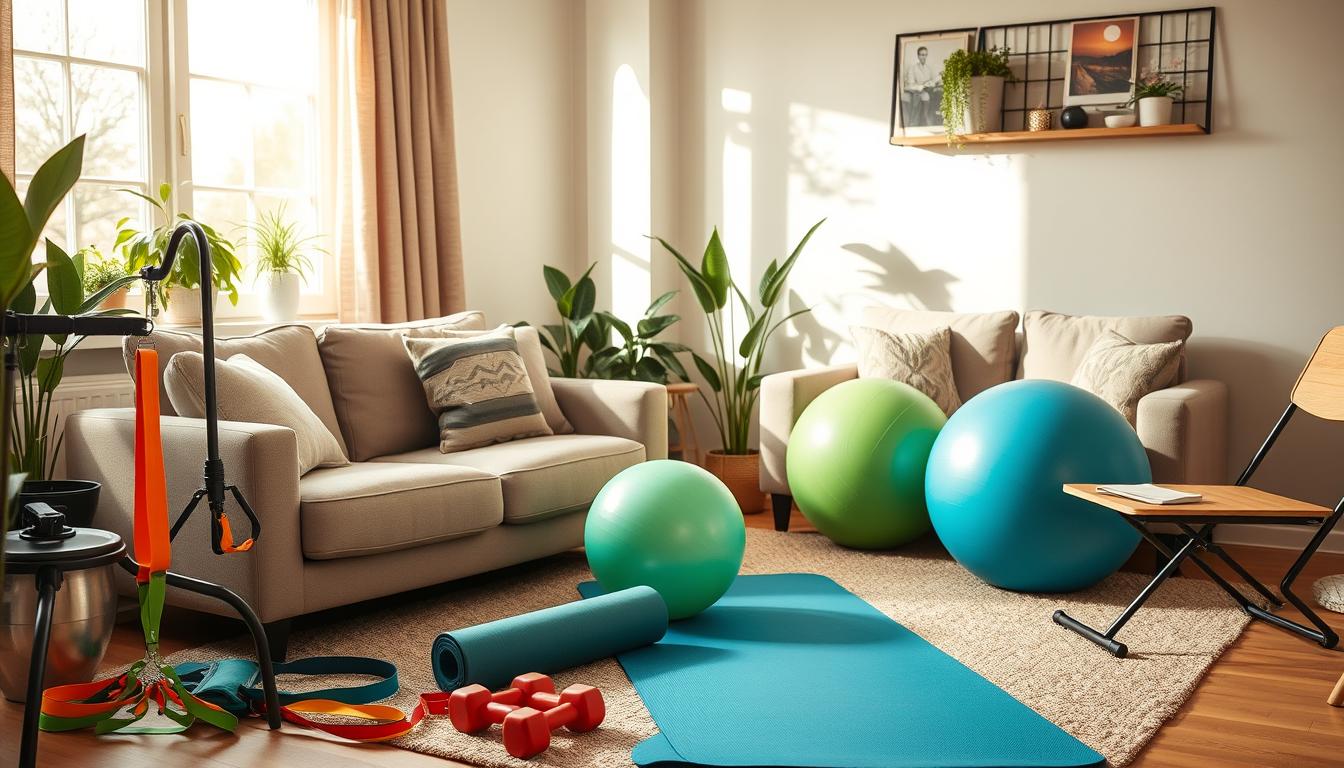
Therapeutic Devices and Tools
Stationary bikes are perfect for endurance training and rehabbing the lower body. They also boost heart health and strength. Ice packs and massage guns help with pain and reduce swelling after therapy. Therapy putty is excellent for strengthening hands and improving mobility, even after neurological injuries.
Safety Equipment Requirements
Balance pads are key for better stability and safely working out multiple muscles. They help prevent falls during exercises. For those with limited mobility, grab bars and non-slip mats are vital for safety during therapy.
Remember, physical therapy at home can be empowering. It helps recovery by allowing more repetition and consistency. Pick equipment that’s fun and keeps you motivated to continue therapy.
Core Balance and Strength Exercises
Core balance and strength exercises are key for preventing falls in the elderly. A 2016 study found that older adults who did balance exercises for 6 weeks improved their balance and felt more confident. These exercises help improve stability and lower the chance of falls.
Physical therapists can design special balance programs for seniors and watch over them during exercises. It’s wise to start slowly, using support like a chair or wall, and then move to more challenging exercises. Some good exercises include:
- Single Limb Stance: Stand on one foot without holding onto a chair, aiming to maintain the pose for up to a minute.
- Clock Reach: Repeat this routine twice per side to improve balance.
- Back Leg Raises: Do 10-15 repetitions per leg to strengthen the lower back and bottom.
- Side Leg Raises: Perform 10-15 times per leg to enhance balance.
A 2019 study showed that balance and coordination exercises can improve the quality of life for older adults. It’s suggested that they exercise at least two to three times a week. If they have health issues or a history of strokes or heart attacks, they should always check with a doctor before starting a new exercise program.
Mobility and Flexibility Training Programs
Functional mobility training is key for seniors to stay independent and enjoy life. It boosts range of motion and movement. This helps older adults stay active and healthy.
Standing and Walking Exercises
Exercises like semi-sits strengthen knee muscles and improve joint flexibility. To boost balance and coordination, try heel-to-toe walks or marching in place. Adults 65 and older should do 150 minutes a week of moderate activity and two days of strength training.
Range of Motion Activities
Keeping core muscles strong is vital for stability and mobility. Chair exercises are great for seniors with mobility issues. They focus on low-intensity movements, flexibility, and range of motion. To enhance circulation and flexibility, add ankle flexions and head turns.
Stretching Techniques for Seniors
Stretching, like low-back rotation stretches, boosts range of motion and reduces back pain. Gentle stretches are best for seniors. They help with muscle strength, flexibility, circulation, joint movement, posture, and balance. Always prioritize safety and comfort during these activities.
Regular mobility exercises can prevent and treat mobility issues in seniors. By adding these training techniques to your daily routine, you can keep and enhance your physical health.
Fall Prevention Strategies and Exercises
Falls are a major risk for seniors, with over 25 percent of adults aged 65 or older falling each year. These falls often cause serious injuries, and 3 million older adults need emergency care every year. To combat this, it’s important for elderly people to exercise to prevent falls.
Physical activity is key to lowering fall risks. Walking, water workouts, and tai chi can boost strength, balance, coordination, and flexibility. Sit-to-stand exercises, which strengthen the legs and improve balance, are also helpful.
Balance exercises are great for unsteady seniors. The aim is to hold each position for 10 seconds, then 30 seconds, with five reps twice a day. Adding strength training to these exercises can significantly lower fall chances.
It is also vital to create a safe home. Remove loose rugs, clear clutter, and make sure your home is well-lit. Night lights in bedrooms and hallways can prevent accidents at night. Using canes, walkers, and grab bars also helps keep you stable.
Seniors can lower their fall risk and stay independent by doing fall prevention exercises and making their home safe. Staying active and aware is the best way to prevent falls and live a safer, more confident life.
Post-Hospitalization Recovery at Home
Seniors often need special care to fully recover after a hospital stay. Post-hospitalization home therapy is a comfortable and effective way to regain strength and independence. Depending on your needs and progress, this care can last from a few weeks to several months.
Transition Care Planning
A smooth transition from hospital to home is key for recovery. Homewatch CareGivers, a trusted provider for over 40 years, offers customized care plans to support this transition. These plans include help with following discharge orders, managing medications, and communicating with healthcare providers.
Progressive Rehabilitation Steps
Your rehabilitation journey starts with gentle exercises and gradually gets more intense. For joint replacement patients, this may involve prescribed physical therapy exercises continuing at home after a stay in a skilled rehab facility. A general guideline is one week of rehab for each day spent in the hospital.
Monitoring Recovery Progress
Close monitoring of your progress is essential during post-hospitalization home therapy. Qualified caregiving teams focus on specific needs, such as recovery from joint replacement, heart surgery, or eye surgery. They also help prevent complications like pneumonia through exercises, maintaining a clean environment, and ensuring good nutrition.
Remember, patients who receive skilled nursing care for rehabilitation have a lower hospital readmission rate than those who go directly home. With proper care and support, you can achieve a successful recovery and regain your independence.
Managing Chronic Conditions Through Home Therapy
Geriatric home rehabilitation is key for seniors with chronic conditions. Almost 54% of home care clients have two or more chronic conditions. This shows the need for effective home therapy is clear.
Arthritis Management
Arthritis is common among seniors, making daily activities hard. Home therapy for arthritis includes exercises for joint mobility and pain management. These exercises help seniors stay independent and manage their symptoms well.
Personalized care plans can cut hospital readmissions by 25% for seniors with chronic conditions.
Osteoporosis Care
Osteoporosis care through geriatric home rehabilitation includes exercises that strengthen bones and prevent falls. These exercises also improve balance and reduce the risk of fracture. Home care is up to 50% cheaper than nursing or assisted living care, making it a good option for many seniors.
Balance Disorders Treatment
Balance disorder treatment includes vestibular rehabilitation and gait training. These exercises improve stability and lower fall risk. Home-based therapy for balance disorders often includes:
- Customized exercise routines
- Mobility assistance techniques
- Use of assistive devices
The chronic condition management plan must be regularly monitored and reassessed. Tools like remote monitoring devices and health tracking apps help manage chronic conditions at home. With 90% of seniors wanting to age at home, geriatric home rehabilitation is a valuable solution for managing chronic conditions while maintaining independence.
Pain Management and Relief Techniques
Physical therapy for the elderly at home is very effective for pain management. Over 50% of older adults deal with pain, and 70% have pain in more than one place. This therapy is done at home, providing care that fits each person’s needs.
Therapists use many methods to help seniors manage pain. They do exercises, manual therapy, and use hot/cold treatments. They also use electric stimulation and ultrasound therapy to help with pain.
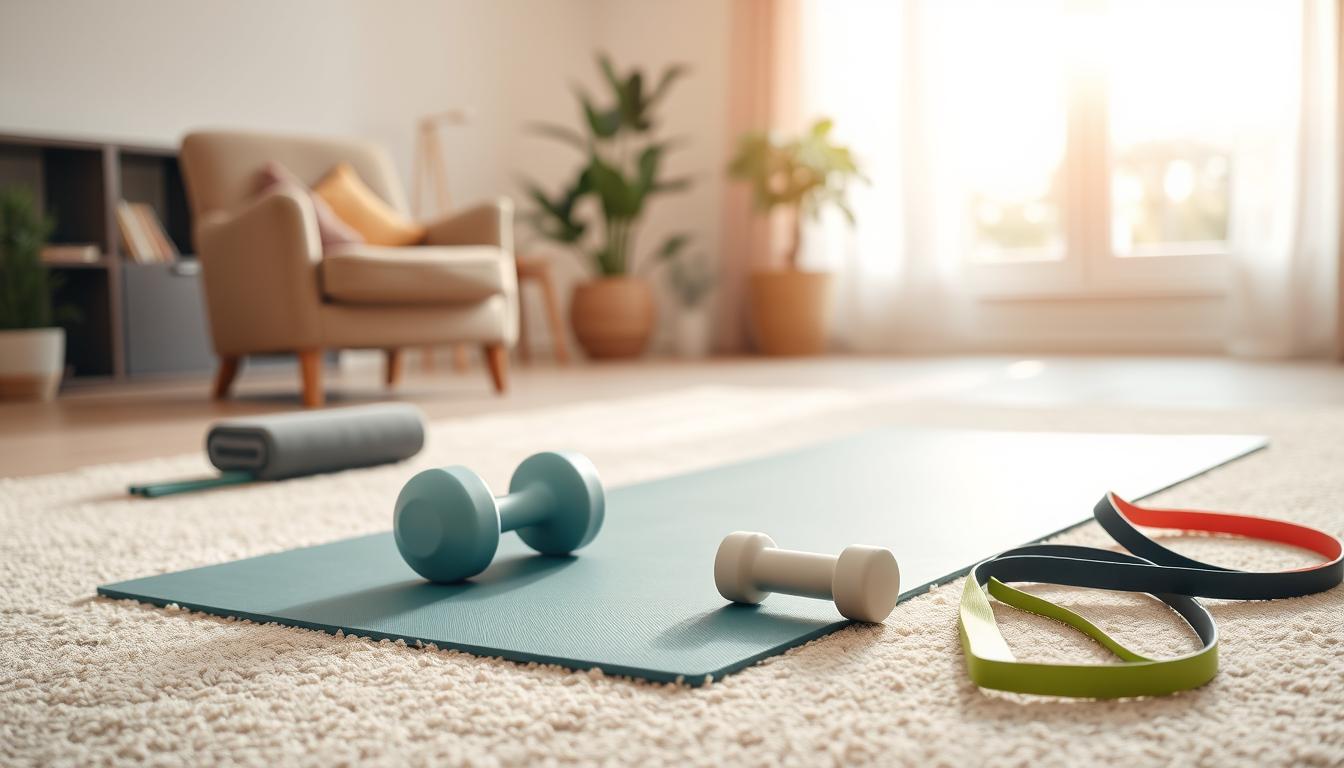
Managing medications is key in home care. Caregivers might handle up to 14 medications a day. Common pain meds include acetaminophen, opioids, and NSAIDs. But, NSAIDs can cause side effects in 30% of users.
Home health care offers many therapies for pain management, including physical therapy, occupational therapy, and skilled nursing care. Medicare and private insurance often cover these, making them affordable.
The comfort of home can help with healing. It reduces stress and anxiety, helping with pain management. Physical therapy for the elderly at home aims to improve their quality of life and reduce their need for pain meds.
Conclusion
Home physical therapy is a great way for seniors to stay healthy and independent. The field has grown significantly since the first Geriatrics Specialist Certification Examination in 1992. By June 2023, 4,112 certified geriatric specialists were ready to help seniors at home.
This care tackles common issues like arthritis, osteoporosis, and balance problems. It helps seniors move better, manage pain, and feel better overall. Regular therapy can also help regain muscle strength and balance, lowering the risk of falls. Falls are a big concern, as one in four elderly people fall each year.
Home physical therapy also boosts mood, reduces depression, and improves thinking and sleep. It’s a full approach that treats conditions and improves life quality. With options like Medicare, Medicaid, and private insurance, it’s getting easier for those needing help.
As our population ages, home physical therapy for seniors becomes even more critical. It’s a key tool for active ageing, supporting independence, and letting seniors enjoy their golden years at home.

